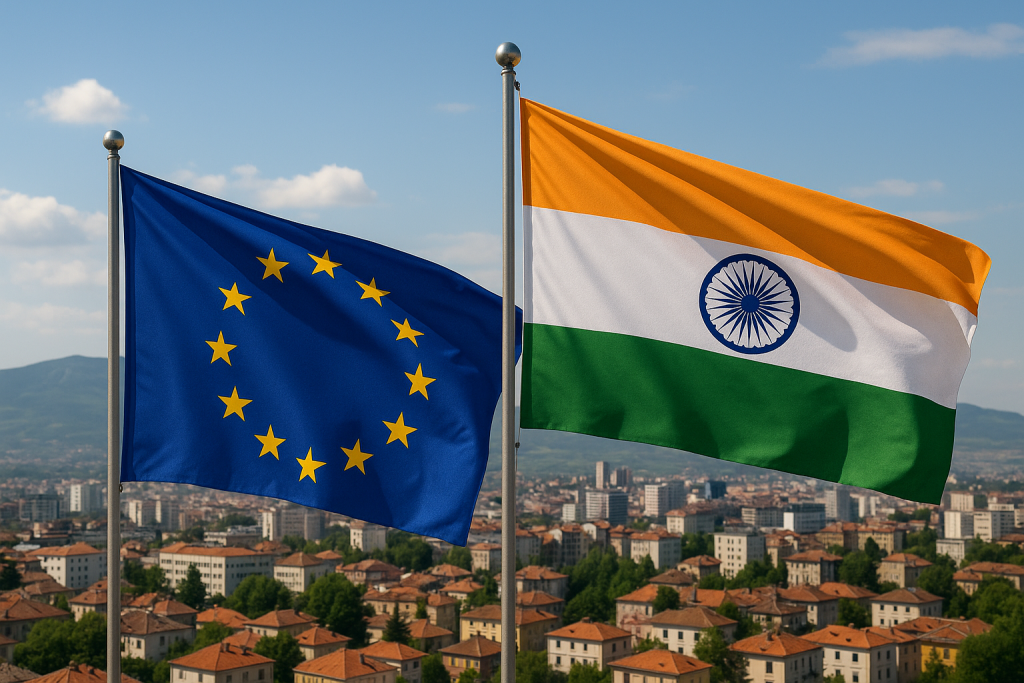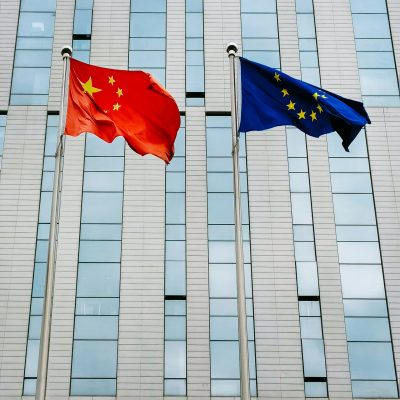Rapport
29/06/23[EN] L’Inde et l’Union européenne en 2030

Recommended citation
Köhler-Suzuki N. et al. 2023. « India and the European Union in 2030« , Report, Paris: Jacques Delors Institute, June.
Executive summary
This report consists of two parts. The first, ‘Bridging Horizons’, focuses on the European view of the relationship, while the second, ‘Strategic Integration’, discusses the Indian view.
Bridging Horizons: EU-India Economic Relations in 2030. A European perspective
India and the EU today
- India and the European Union face multiple shared crises, from the pandemic to climate change and the global transition towards a multipolar order. They also share concerns about the weaponisation of economic interdependence and have taken separate but similar steps towards increasing their economic security.
- While some in the EU see India as a partner to preserve democratic principles in global affairs, there is lack of understanding of India’s post-colonial identity, which shapes its response to events such as Russia’s war on Ukraine.
- Even so, given their common concerns, the EU and India have a unique opportunity in the 2020s to deepen their partnership and shape the global agenda on trade, digitalisation, climate change, and security.
- Improving economic ties will be key to realising the true potential of the strategic partnership between the EU and India. However, previous negotiations on a free trade agreement failed in 2013 due to divergent preferences.
- The EU-India relationship could be a major contributor to the European Commission’s desire to “de-risk” the EU’s trade and investment relationships. India can provide the EU with a valuable trade partner and access to a large and growing market, while the EU has the potential to provide India with the investment, technology, and market access it needs to grow its economy.
What can the EU offer India?
- While merchandise exports from the EU have increased from US$12.6 billion in 2000 to US$46.3 billion in 2021, their rate of growth is not fast enough to significantly diversify the EU’s economic relations.
- Twenty product categories make up 90 percent of total EU goods exports to India, with industrial machinery, stones and metals, aerospace and electrical machinery accounting for half of EU exports.
- The share of EU exports to China (10 percent) correspond to approximately half China’s weight in the global economy (19 percent), but EU exports to India (2 percent) are only a quarter of India’s weight (7 percent).
- The removal of market access barriers would open this additional opportunity for EU exports and help diversify merchandise exports away from China.
- All but one of the top 20 EU exports to India have seen a reduction in their share of Indian imports over the past decade, particularly following India’s signing of FTAs with Japan, Korea and ASEAN.
- Most EU services exports to India have been growing in absolute and relative terms.
What can India offer the EU?
- EU imports from India more than tripled in the 2000s – but increased at a slower rate, from US$44 billion to US$54 billion, between 2010 and 2019. Since 2010, India’s share in the EU’s import basket has stagnated, compared to the growing share of EU imports that come from China.
- The fastest growing sectors for imports include aluminium, iron, steel, rubber, and furniture. Some of these sectors may be impacted in the coming years by the introduction of a carbon border adjustment.
- In more than a third of EU import sectors, the share of imports from China makes up a quarter of the total. India offers opportunities for the diversification of imports in sectors such as men’s clothing, organic chemicals, and motorcycles. But it is unlikely to replace China as a major source of imports by 2030.
- Imports of telecommunications and IT services from India already surpass those from China. However, other services imports from India are below the share they had a decade ago or are insignificant.
The investment relationship
- India’s current foreign direct investment (FDI) intensity ratio is 1.9 percent of GDP, higher than China’s or the OECD average. Communication, computer services, and retail have seen the highest FDI growth.
- However, the policy context for FDI in India is challenging, partly because India unilaterally terminated bilateral investment treaties. The share of European affiliate enterprises in India, and its share of employment in these enterprises, has been growing, while China’s shares have been decreasing – indicating India’s increasing importance to European business.
- EU manufacturing investment in India has primarily sought to serve the domestic Indian market, and so India has not been able to replace China in global value chains. This has partly been due to an unstable tariff environment.
- Predictable tariffs and harmonised rules would further increase business confidence and investment.
Challenges to deepening co-operation
- There is a tight timeframe to conclude negotiations on an India-EU FTA before India’s general election in 2024.
- India will expect some agreement on visa quotas, to enhance its services exports, but this remains the competence of EU member states.
- India’s new bilateral investment treaties are relatively shallow, and aligning India-EU approaches on investor protection will be complex.
- India’s industrial policy has a strong focus on domestic car production and it may have difficulty lowering tariffs on EU car imports.
- Market access for alcohol will be difficult as, unlike other markets, it remains the domain of 28 different states with different duties and licensing laws.
- India’s procurement market discriminates against foreign suppliers. It is also shared between India’s federal and state levels, adding to complexity.
- The EU and India have significantly different approaches to digital regulation since India’s emerging regulatory framework may lack the EU’s comprehensive protections for personal data. Effective lobbying by US firms might sway it further away from European standards.
- While India has promised to address such issues, FTA negotiations have only progressed slowly. India is interested in concluding an “early harvest” agreement, as it has with Australia. But the EU sees this as in conflict with its WTO obligations.
- Demands from European civil society to account for sustainable development clash with India’s emphasis on sovereignty and suspicion of hidden protectionism. India is particularly sensitive to developed-country efforts to impose their will on developing countries through trade policy.
- The EU must also work harder to convince Indian opinion that its emphasis on sustainable development is not driven by protectionist instincts. While India must realise that there is a pro-sustainability consensus in the EU, collaboration to increase rather than decrease trade in the sectors affected by mechanisms like CBAM is essential.
Strategic Integration: EU-India Cooperation in 2030 A view from India
Context: India-EU Relations in Strategic Perspective
- The EU-India partnership has gained momentum through increased political and economic outreach. Factors driving this shift include India’s economic growth, the EU’s need for diversification, shared goals in renewable energy and climate change, and strategic convergence on India’s role in the Indo-Pacific.
- The EU is India’s third-largest trading partner, accounting for about 11% of India’s merchandise trade. However, India’s exports to the EU are currently limited by the absence of duty-free access, resulting in underperformance compared to competitors.
- India’s economic priorities, including increasing economic security, integrating into global value chains (GVCs), enhancing the digital transformation, transitioning to a green economy, and attracting private sector investment, are pointing to the need for the EU-India trade relationship to intensify to meet India’s developmental needs.
The Investment Relationship
- India’s private sector investment has declined as a percentage of GDP since 2012. Geographical diversification and capacity utilisation constraints limit private investment, making FDI crucial for corporate investment.
- FDI in India has historically been lower compared to China, with marginal growth in its share of gross capital formation. European investment, known for its quality and transparency, has surpassed investments from the US and Japan.
- The need to increase FDI flows into India is a key reason for the Indian government’s push for greater economic integration. The Indian government’s ‘Make in India’ initiative aimed to attract foreign direct investment (FDI) for job-creating mass manufacturing and integration into global value chains (GVCs). However, the emphasis on investment promotion sometimes overshadowed the importance of GVC integration, resulting in limited success in attracting manufacturing FDI.
- The revocation of bilateral investment treaties and reduced investor protections have impacted FDI flows and raised concerns among foreign investors, including the EU. Resolving differences in mindset and dispute settlement approaches is crucial for expanding EU investments in India.
Sectors and Challenges for Exports
- India’s merchandise exports to the EU have grown, but the EU’s share in India’s total goods exports has declined due to higher tariffs, differing standards, and non-tariff barriers.
- Indian agricultural exports face challenges in complying with European standards and tariff barriers, while efforts to increase exports focus on digital interventions, food safety regulations, and organic agriculture.
- Opportunities exist for increased demand for Indian steel in the EU due to the war in Ukraine, but high tariffs and the EU’s Carbon Border Adjustment Mechanism pose challenges.
- Textiles and apparel are under-performing sectors for India’s exports, but an FTA with the EU could enhance competitiveness with lower tariffs and domestic reforms.
- Despite India’s competitive manufacturing costs, trade between India and the EU in the pharmaceutical sector is limited by complex regulations and data integrity concerns.
- Collaboration in the automotive industry should prioritise lower-emissions technology and EVs, with a focus on regulatory frameworks, innovation, and infrastructure development.
- Enhancing bilateral economic relations in the chemicals sector requires regulatory coherence, simplification of licensing procedures, and stronger intellectual property protections.
- Barriers exist in India’s services sector, particularly for foreign service providers, but opportunities lie in healthcare, digital services, and professional services through agreements with individual EU member states and Mode 4 trade.
The Case for Imports
- India’s past trade policy has limited its growth in manufacturing exports and integration into global value chains. Dual objectives of protecting industry and participating in GVCs have led to inefficiencies.
- Import substitution has not been effective in India due to the size of its domestic market, hindering its ability to compete globally. India’s participation in GVCs is below its contribution to world trade, highlighting the need for greater openness to imports and participation in value chains.
- The European Union plays a crucial role in providing intermediate goods and technology for Indian production and moving up the value chain. India’s eroding gains from trade liberalization and renewed interest in FTAs, particularly with the EU, reflect the need for greater openness and integration into global trading networks.
Two Challenges to Integration
- India has been hesitant to open its public procurement market to foreign businesses. The EU is interested in accessing India’s lucrative public procurement market through an FTA. India’s recent FTA with the UAE includes a chapter on government procurement, signalling a potential shift in India’s attitude.
- Liberalisation of public procurement in India would create opportunities for European firms and address India’s infrastructure deficit. A transparent procurement system could attract foreign investors and increase local competition in India. Indian firms could benefit from accessing the European public procurement market, especially in services and IT. Closer engagement with stakeholders in India would help create support for positive change and integration in the public procurement sector.
- India is concerned about the EU’s inflexible stance on labour, human rights, and environmental standards. Differences in environmental standards and the EU’s imposition of extra-territorial corporate due diligence create challenges in finding common ground. The Indian government voices concerns that excessive civil society involvement in trade raises issues of democratic accountability.
- Bilateral trade deals with agreed glide paths and emphasis on promoting sustainable development could address doubts regarding climate change and non-tariff barriers. Mechanisms for regulatory harmonisation and cooperation should be prioritised. Focus on incentives with common but differentiated responsibilities, and transparent interaction could facilitate progress on labor and environmental standards.
- Both the EU and India prioritise sustainability, particularly in reducing greenhouse gas emissions and promoting resource efficiency. Closer integration between the EU and India can benefit trade, innovation, and cost competition for green transition goods. India needs a clear transition plan to carbon neutrality, and sector-specific sub-plans can help determine the net-zero compliance of tradable commodities.
- India is reforming its labour codes and aims to align them with international conventions. Occupational safety requirements can be addressed, but there are challenges regarding labour rights for government employees. Understanding Indian constraints and finding legal solutions can prevent labour sustainability standards from becoming a hurdle in the FTA negotiations.




